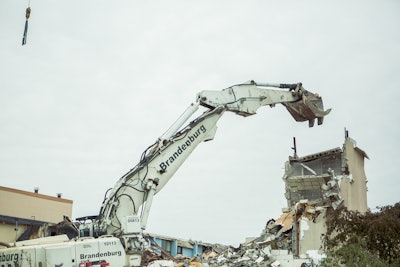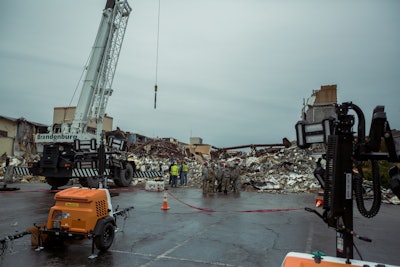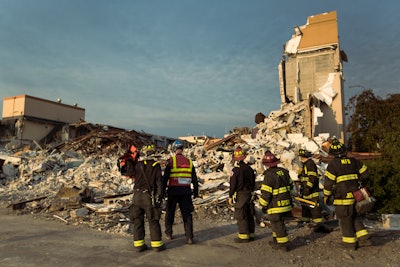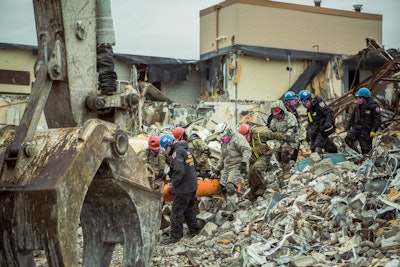
Information from this article was first published in National Demolition Association and is being reused with permission from the Demolition Magazine.
By Alexa Scholosser
If you were at the Radisson Hotel in Merrillville, Indiana, on May 8-10, you would have seen a partially collapsed building, trauma tents, search-and-rescue dogs, drones with infrared cameras, a bevy of heavy equipment and more emergency responders than you could count. You would have thought a tornado ripped through the hotel. Because that’s exactly what it was supposed to look like.
Perfect timing
The Radisson Hotel at Star Plaza was the site of a highly coordinated, multi-organizational disaster response training exercise led by United Front, an exchange program between the Indiana National Guard and the Israeli Defense Force Home Front Command Search and Rescue Unit. The program has been running for six years, going back and forth between countries each year. The purpose of the exercise is to exchange training, tactics and procedures on search and rescue. This year, the event came together rather organically.
 Brandenburg Industrial Services was responsible for collapsing the hotel in different ways allowing the rescue teams to train using all their resources.
Brandenburg Industrial Services was responsible for collapsing the hotel in different ways allowing the rescue teams to train using all their resources.
“I read in the paper that the Radisson was closing and they were going to tear it down,” says Tim Tully, division chief of the Crown Point Fire/Rescue Department. “I immediately reached out to White Lodging [the property owner] and Jay Settergren from Indiana Task Force 1.”
Indiana Task Force 1 (IN-TF1) is comprised of emergency responders from public safety and private sector agencies trained to respond to local and national emergencies. Initially, Tully thought it would be a good opportunity for a small training between IN-TF1 and his fire department, but he quickly learned that United Front was looking for a venue.
“The timing worked perfectly, and the site was incredible,” Tully says.
Over 20 agencies participated, including the Crown Point and Merrillville fire departments, the state Department of Homeland Security, and task forces from Michigan, Iowa and Illinois, among others.
“There are a lot of moving parts when you have that many agencies involved,” says Thomas R. Neal, battalion chief at the Indianapolis Fire Department and training coordinator with INTF1. “Each agency brings with it a unique set of experiences as well as personalities, equipment and skill sets. However, it allows agencies to work together in an exercise that builds relationships prior to a real-world emergency.”
Setting the scene
NDA member Brandenburg Industrial Services was first introduced to the training exercise during the bidding process with White Lodging Services Corporation for the Radisson Hotel demolition. The property owner asked bidders “to keep an open mind” about potentially being involved in a disaster simulation, says Dennis McGarel, vice president of sales and estimating at Brandenburg.
 Brandenburg Industrial Services demolished one part of the building to rubble, structurally compromised another area leaving large pieces, and pulled the roof of the atrium off its supports allowing it to collapse.
Brandenburg Industrial Services demolished one part of the building to rubble, structurally compromised another area leaving large pieces, and pulled the roof of the atrium off its supports allowing it to collapse.
Brandenburg won the bid and soon met with the other agencies involved to discuss the details of the “tornado.” The Radisson Hotel complex had a high bay atrium with a large open area at the entrance, which was surrounded by hotel rooms that looked into the open area. The agencies explained that having both large open areas and smaller congested areas of hotel rooms stacked on each other was ideal for search-and rescue training.
But before the exercise could begin, the scene needed to be set. First, Brandenburg removed any environmental concerns and allowed the agencies to place their “victims” throughout the structure. Then, Brandenburg collapsed the buildings in various ways.
“One section of the building was reduced to near rubble, another area was structurally compromised but left in large pieces, and the atrium area had the roof pulled off its supports and collapsed,” McGarel says. “The idea was to create different areas for the rescue teams to use all of their resources.”
Over 40 hours of searching
“The way the drill was planned was to simulate a disaster situation from the beginning stage of the event to the end,” Tully says. “We began the exercise with a 911 call to the local fire department. Upon arrival, they requested local and regional resources. The event escalated in a real-life way, culminating with the National Guard response. It was a very realistic example of the way a real life scenario would play out.”
 Part of the disaster response training coordinated the “treatment” of the injured onsite.
Part of the disaster response training coordinated the “treatment” of the injured onsite.
The exercise ran continuously from 2:30 p.m. on Monday, May 8, to noon on Wednesday, May 10. The rescue teams had debris cameras to search holes, canine teams, shoring systems, hand tools and heavy equipment, and drones with infrared cameras to search the debris. They coordinated the “treatment” of the injured on-site and timed the helicopter units’ round trips to the hospital with “victims” to decide if there was time to transport or not.
“The event was extremely impressive to witness,” McGarel says. “They addressed details an inexperienced person would have never considered.”
Throughout the exercise, a discussion arose regarding the role demolition contractors can play in emergency situations, McGarel says.
“There is an opinion in the industry that the first companies turned to in these situations are construction companies due to the equipment needed,” he says. “In working with and talking to the various agencies, it became apparent that there was an appreciation for what an experienced demolition crew can contribute in this type of environment.
The special equipment attachments to handle debris, the specialized personal protective equipment and the mindset of working with a compromised structure is normal for a demolition worker. The Brandenburg personnel became just another part of the very impressive response team. The agencies that we were able to work with expressed an appreciation for what a demolition company can bring to assist first responders in an emergency situation of this magnitude.”



















